GoPro HD Hero 2
-
-
Written by Ken McMahon
Intro
The HD Hero 2 is GoPro’s latest wearable and gear-mountable camera. Announced in October 2011, the HD Hero 2 builds on the enormously popular HD Hero with ultra-wide 170 degree video at 1080p, higher resolution stills, faster timelapse and burst shooting at 10fps. In this review you’ll see how this new camera performs around Queenstown, New Zealand, the adventure capital of the world!
The HD Hero 2 shares the same dimensions as the earlier HD Hero, which allows it to share the same mountings and accessories, which in turn means you can attach the camera to almost anything. Whether you’re into mountain biking, kayaking, snowsports, skydiving, automotive or virtually any other activity, the HD Hero 2 can capture ultra-wide angle stills and HD video of your favourite sport. Seal it in its supplied housing and it’s also waterproof down to 60m.
Once again the headline upgrade is the ability to capture Full HD 1080p video with ultra-wide 170 degree coverage, whereas the earlier HD Hero could only achieve this at 720p (16:9) or 960p (4:3). If you’re into slow motion, a new 120fps mode at 848×480 will slow the action by four times. The still photo resolution has been boosted from 5 to 11 Megapixels and you can now take a burst of ten shots in one second. The timelapse feature which takes photos automatically at preset periods is now available at half second intervals, and there’s now both HDMI and external microphone ports. Perhaps most exciting of all is the upcoming Wifi accessory which will allow you to remote-control up to 50 HD Hero 2 cameras using a smartphone and even view their feeds on-screen.
Camera Labs’s base in Queenstown, New Zealand, is the perfect place to test the HD Hero 2. In what’s widely regarded as the adventure capital of the world, we have access to some of the best outdoor activities from mountain biking to sky-diving, amongst some of the most stunning landscapes in the world. No wonder the earlier HD Hero quickly became the must-have camera around town.
Suffice it to say there was a great deal of excitement around Queenstown when we started testing the HD Hero 2. Everyone from enthusiasts to adventure operators wanted to see how it compared to the old model. So we decided to have some fun and really put the camera through its paces by filming the best that Queenstown has to offer for the adventurous traveller. To do the camera real justice I knew I had to get it in the hands of someone who knew the previous model back-to-front and who’d take it on the most exciting activities. I know no-one better-qualified to do this than writer, photographer and film-maker Scott Kennedy, who some of you may recall from my Canon 8-15mm fisheye review. Scott’s written an in-depth review of the camera to which I’ve added my own image and video quality comparisons, but to kick-off the review here’s our two-part video demo!
| |
|---|---|
|
| |
| |
| |
GoPro HD Hero 2 review, by Scott Kennedy
| ||||
The latest offering from GoPro is less of a new camera and more of an improvement on an already tested and trusted model. GoPro has created their own niche camera market in the world of sports photography. By sports photography I’m not referring to taking photos or shooting video of other people at play – GoPro’s cameras are designed for the participants themselves to use. Designed to be strapped to a helmet, affixed to a surf board or lashed to a mountain bike GoPro’s are aimed at users who wouldn’t necessarily refer to themselves as photographers. These camera’s are all about capturing the action from the inside of the adventure.
The third installment in the Hero line is the highest spec unit yet and is a logical incremental improvement over the previous model The HD Hero. The question is – are these changes a game changer? Should current GoPro users put their current version on the shelf and shell out for the new one? And what about those new to the helmet cam market – is this the one to choose?
In an effort to push this camera to the limits, Camera Labs has gone to unprecedented extremes to put this new model into perspective. Mountain biking, kayaking, zip lining, bungy jumping and skydiving – all with a GoPro HD Hero 2 firmly attached. So settle in, hold on and see if this is the camera to take on your next adventure.
GoPro HD Hero 2 design and build quality
The HD Hero 2 retains the same robust build as its predecessors. In fact from the outside it looks almost identical. This means if you’re an existing GoPro user your mounts, attachments and housings are all interchangeable with the Hero 2.
The outward aesthetics of the GoPro are polarizing to say the least. If you’ve not seen one before you’d be forgiven for thinking it was a toy intended for pre-school photographers. The exterior hard plastic shell protects the camera itself but certainly won’t win any beauty contests. The beauty in this beast is its durability. The sealed housing can submerge to a depth of 60m so not only is it a perfectly acceptable surf and kayak camera, using it while scuba diving and snorkeling is also a real option.
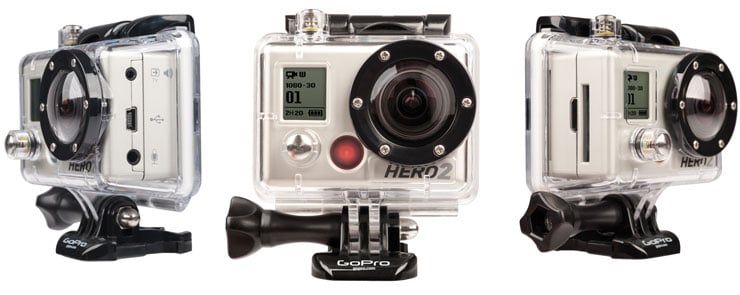 |
The clear hard plastic shell is accessed through a latch on the top of the camera case that opens much like a pelican case. Once the latch is opened the back hinges off and the camera itself can be removed. The door through the shell has a waterproof seal and is reliable to keep water out.
The downside to this robust exterior is the virtual inability to record sound using the built-in microphone. GoPro gets around this by supplying a second door that can be interchanged with the sealed version. This sound friendly door has two large holes in it that allow sound to pass through with less obstruction. The downside is those same holes allow moisture and dust to pass through, so you have to decide whether you want to sacrifice full weatherproofing for audio capture. But even if you go for the former, the hard plastic shell will still protect the camera within from knocks – good job too as the naked camera itself is made from thin plastic and has a convex lens just asking to be scratched. This design means that it will predominantly live in its hard protective housing.
Of course the exterior housing needs a window for the camera’s lens to view the action, and this convex shaped part represents one of the improvements on the Hero 2. It is now thinner and clearer than before, adding to overall sharpness. This exterior lens window is also replaceable if it gets scratched in the heat of the action. As this is the thinnest part of plastic on the unit it is often the first thing to fog up when there is a change in air pressure. GoPro offers some moisture absorbing pads that insert into the housing to combat this problem. They weren’t tested as part of this review, but reports suggest that they are quite effective.
The camera itself is the very essence of minimal engineering. Like its predecessor, there are only two buttons: a mode button on the front and a shutter button on the top. The camera is powered-up with a prolonged press of the mode button and with that same button you can scroll through the various shooting modes and options. One improvement over the previous HD Hero is the buttons themselves – they now have a rubberized coating to make shooting while out of the housing a bit easier. The plastic housing is unchanged from previous models and can be freely interchanged between models.
One major change and improvement over the original HD Hero is the addition of several lights to the exterior. The earlier model had just one red light on the front that would indicate if it was recording video or counting-down a self-timer. Now the HD Hero 2 not only has the same light on the front but also three more small lamps on the top, back and bottom. While this may sound like a small improvement of negligible value you have to remember the context that this camera is intended. While mounted in a chest harness, clamped to the bottom tube of a mountain bike or on the end of a ski pole – actually knowing when you are shooting is crucial. Like virtually all GoPro users I’ve experienced the frustrating phenomenon of thinking I was recording some once in a lifetime action, when in fact I wasn’t.
Another change over the previous model is the selection of ports on the exterior of the camera. The right side is where you will find the SD card slot alongside a new HDMI port for connecting directly to an HDTV. To shoot video you will need a card rated 4 or faster – but to support the new half-second time-lapse mode, you’ll need one rated at Class 10. The ideal size of card depends on how you are going to use the camera. With a battery life that often signals the end of your shooting day an 8GB card is usually sufficient.
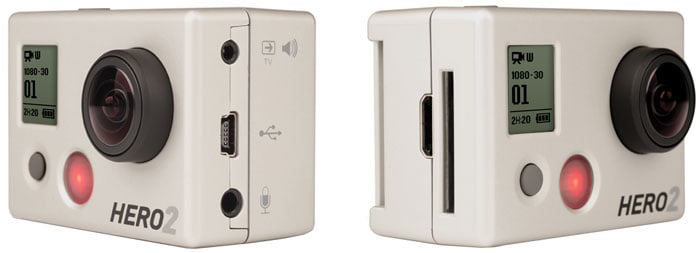 |
The bottom of the camera is where you will find a new tiny on-camera mic; this is in addition to the one found on the top, although again you won’t be capturing much audio from these without fitting the case door with the holes in it. The back of the camera is home to the battery cover and accessory port – I’ll explain more on those later. The left side has three ports – a standard composite video output, the USB interface that is also used to charge the unit, and, replacing the old component video output, a new 3.5mm external mic input.
Traditionally the audio from GoPro footage has been universally terrible. The plastic housing prevents all but the loudest of sounds penetrating and the vibration, rattling and wind from movement is often the only transferred sound. So the presence of an external mic input sounds like a great solution, except for the fact that the only way you can access it is to have the camera outside of the protective housing, at which point it’s vulnerable to knocks or moisture and lacking any easy mounting interface. I accept for full weatherproofing you normally need to sacrifice access to ports, but it could have been so much more useful if the external microphone port were on the rear and thereby accessible through the alternative door with the holes in it. I hope GoPro addresses this in the future.
The front of the unit looks nearly identical to its predecessor. The lens now has a black bezel as opposed to silver and has a rubberized ring around the outside of it. This addition is presumably to help it seat better within the housing.
GoPro HD Hero 2 Internal workings
The biggest improvements and changes with the GoPro HD Hero 2 are found inside the camera itself. These can be broken down into three categories – sensor, lens and display.
Sensor
The sensor on this new unit is a big improvement over the previous model. Technically speaking it’s slightly larger at 1/2.3in compared to 1/2.5in, but this small change in numbers doesn’t do justice to the dramatic improvement you’ll experience in image quality. While testing both cameras side-by-side, three things really jumped-out.
The first is a noticeable increase in color saturation and richness of the image. When comparing the video from the HD Hero 2 against its predecessor you’d be forgiven for thinking they were taken on different days – the difference is that big. The original HD Hero produced images that looked desaturated, flat and lifeless. In contrast the HD Hero 2 recorded rich, saturated images that popped off the screen. This was only amplified as the quality of light improved. In bright sun both cameras produced lively images, but those from the HD Hero 2 were a cut above; you can really see this in the side-by-side portions of the video reviews above.
GoPro HD Hero 2 video grab |
GoPro HD Hero 1 video grab | |
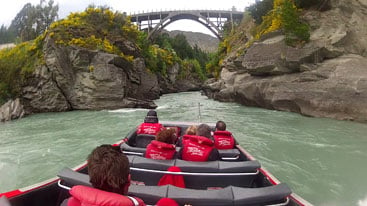 |
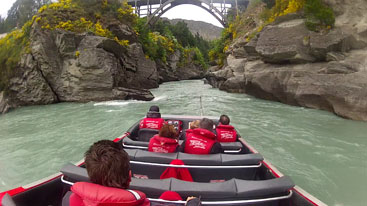 | |
Low light performance, or lack there of was a failing that had dogged the GoPro HD Hero on previous occasions. It just couldn’t handle the high ISO’s and the image noise was all but unbearable. The HD Hero 2 has gone a long way in improving this as you’ll see in the results pages, but it still has some distance to go. These cameras are made with blue sky and sun in mind, so pushing them into the shadows gets results that are mixed at best. When you compare the footage of the two cameras you can see the improvement and also where it needs to go. Check out the HD Hero 2 sample images and HD Hero 2 sample movies and you’ll see how it excels in bright light, but quickly becomes noisy in shadows – even shadows on bright days. On the HD Hero 2 movie samples page you’ll also see how the video footage becomes even noisier when you switch the camera to the narrower fields of view (127deg and 90deg). At its narrowest the noise level is very high. But again compare it to the previous HD Hero and it’s still a major improvement.
The third improvement in the imaging pipeline regards automatic exposure adjustments. Like its predecessor, the HD Hero 2 is fully automatic for exposures, so you’re reliant on it getting it right under often quickly changing conditions. The original HD Hero was notorious for being sluggish at best in compensating for changing light. For this reason alone it was deemed un-usable by some commercial skydive operators for filming their jumpers. The change in light from the interior of the plane to the outside sky when the daredevils leapt from the plane was just too quick for the old model. The improved imaging pipeline in the GoPro HD Hero 2 has vastly improved upon this and tackled the issue head on. You can see in the side by side footage in the video review above, especially in the kayaking footage, that when the camera is dunked underwater it quickly changed exposure and then when it was back on the surface changed again. The previous model lagged so far behind that the footage from underwater simply registered as black.
GoPro HD Hero 2 Lens
The new lens is another big improvement in two ways – sharpness and field of view.
Sharpness
GoPro claims the lens on the HD Hero 2 is twice as sharp as its predecessor. That’s hard to measure, and of course image processing also plays a big role on the final image, but the bottom line is stills and video from the HD Hero 2 are much crisper than before. Though the sharpness of the old model was passable, ‘for a helmet cam’ the new sharper lens and processing has set the standard. When you look at the side by side footage of the Shotover Jet in part 2 of the video review above, you can really see the difference in sharpness between the two of them.
Field of view
The combination of a wider lens and larger sensor now supports a broader field of view at the top video resolution of 1080p. While the original HD Hero could shoot at 1080p, you were limited to a field of view of 127 degrees. To get the full 170 degree coverage you had to reduce the video resolution to 960p in 4:3 or 720p. The HD Hero 2 now lets you enjoy 1080p at 170 degrees, and also offers two narrower field of views at 1080p: 127 or 90 degrees, although as noted above, the noise does become progressively more obvious as the field of view narrows.
1080p footage is captured at 30fps and encoded with H.264 into an MP4 file. You can alternatively shoot at 960p (4:3) at 30 or 48fps, 720p at 30 or 60fps, or WVGA (848×480) at 60 or new to the HD Hero 2 at 120fps. The latter allows you to slow footage by four times in a 30fps project, and we have a demonstration in part 2 of the video review above. Owners in PAL regions can switch the frame rate to 25, 50 and 100fps in the respective modes.
GoPro HD Hero 2 Display
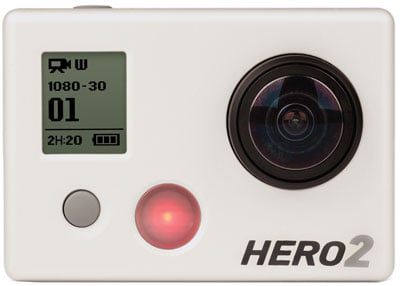 | |
One of the first improvements previous GoPro users will appreciate is the new display, which looks the same when powered-off, but will delight as soon as it’s switched on. Previously when adjusting the mode, resolution or other settings on the original HD Hero, you were reliant upon deciphering a series of one or two letter codes. Despite using the camera frequently over the past year I’m still yet to determine what all the hieroglyphic symbols mean. The instruction manual always went with me wherever I took the camera.
The new display is a breath of fresh air. Gone are the mysterious codes and the need for the instructions stuffed into my ski jacket.
In their place are clear icons and real words saying things like “1080 – 30” with “W” at the top meaning the camera’s set to 1080p video at 30fps with the Wide field-of-view. The icon-driven menus are also easy to understand, simple to navigate and logically organized. It’s obvious that GoPro has listened to a cascade of feedback and has acted upon it for this new model.
GoPro HD Hero 2 Still images
While predominantly intended for moving pictures, the GoPro can also shoot stills. Previously the HD Hero 1 could shoot 5 Megapixel stills with a 170 degree field of view. On the new HD Hero 2, the coverage remains 170 degrees, but the resolution has shot-up to 11 Megapixels.
The challenge with shooting stills on the bare GoPro will always be the lack of a built-in screen or viewfinder. Traditional photographers will struggle to line up shots and all of us habitually used to checking our images will feel like we’ve returned to the glory days of film. There are accessories which can fix the problem I’ll mention in a moment, but the HD Hero by itself will frustrate those who have come to rely on screens not just for composition, but also for playback to confirm capture.
Indeed when you plug the camera into your computer after a day of shooting, it can often be a surprise to discover exactly what you captured on your stills. Remember this is a camera designed for action sports – not for shooting architecture in Paris. Having said that in its element – it does excel. When the subject is close and filling the frame and the light is good the images are pretty good. What often helps to overcome technical limitations is the visceral quality to a photograph taken mid way through a skydive. This is perfectly illustrated in the two shots below, and those in the HD Hero 2 sample images gallery. Try and use the HD Hero as a normal digital camera for walk-around photography and you’re likely to be disappointed, but jump out of a plane with one and you’ll be delighted.
GoPro HD Hero 2 photo (normal conditions) |
GoPro HD Hero 2 photo (exciting conditions!) | |
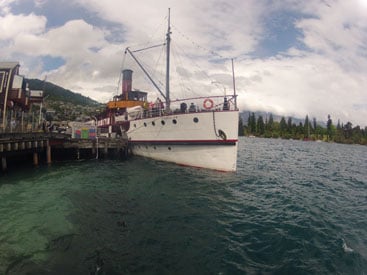 |
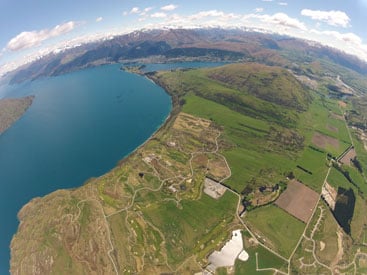 | |
To assist users in getting strong images several features are included. One new feature is a one second burst where 10 shots are taken. This is particularly handy when photographing your friend hitting a jump in the park or base jumping off The Eiger.
The camera also features a time-lapse mode where images can be taken every .5 (new), 1, 2, 10, 30 or 60 seconds. These images can then be easily stitched together in a program like QuickTime Pro to create some pretty spectacular timelapse results. With its robust construction, this is the sort of camera you don’t mind leaving outside all day. Here’s an example filmed with the new 0.5 second mode.
| |
|---|---|
|
GoPro HD Hero 2 Battery
The battery life of GoPro’s has often been a limiting factor in shooting all day. With a claimed average battery life of 2.5hrs you’re limited at the best of times. Through experience, that 2.5hrs is a standby time – actual shooting time is often much less than that. If you plan on shooting extensively every time you use the GoPro a second battery is highly recommended. On the plus side recharging is simple and quick with a supplied USB cable – total time to recharge is about 2hrs. You can also charge via any third party wall socket to USB charger with quicker recharge times of about 1hr.
GoPro HD Hero 2 Accessories
One of the limitations of the GoPro system is the lack of a built-in screen. GoPro addressed this for the previous HD Hero with the optional LCD BacPac accessory which bolted to the back and handily came with a new rear door to keep everything weatherproof. This accessory is also compatible with the latest HD Hero 2.
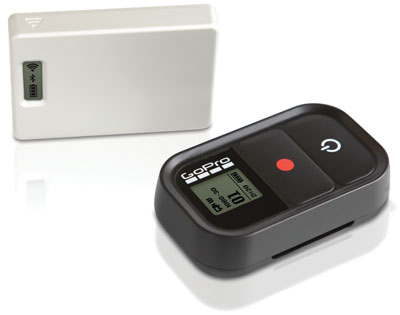 | |
There is also a 3D system which is essentially two external housings fused together. You put two identical GoPro cameras in, sync them together and shoot away. With the included software (and glasses) you can create your own 3D movies. It might not be Avatar, but it might be the easiest way to get your mum to go bungy jumping – or at least feel like she did.
The newest accessories are also the most exciting. In early 2012 GoPro hopes to launch its new Wi-Fi BacPac and Wi-Fi remote control – see photo opposite. Fit the Wifi BacPac to the original HD Hero and you can use the remote control to trigger the shutter. Fit the same Wifi BacPac to the new HD Hero 2 though and you’ll alternatively be able to control it with a tablet or smartphone, and even use their screens to see what the camera’s capturing.
You can also review footage, trigger the shutter and live stream directly to the net. With the app you can control up to 50 HD Hero 2’s from a single tablet or phone. Combined with the 10 shot burst capabilities the reality of both ‘Bullet Time’ on a budget and directing your own snowboard movie from the lodge in real time are a fun reality. The Wi-Fi back is set for release soon and we’re excited to test it when it does – watch this space.
Now for some more results from the HD Hero 2. On my GoPro HD Hero 2 photo quality page you’ll see how the stills compare to its predecessor. Meanwhile on my GoPro HD Hero 2 movie quality page you’ll see some examples of how the videos compare to its predecessor. If you’d like to see more still photos, check out my GoPro HD Hero 2 sample images page, or if you’ve already seen enough, head straight to my GoPro HD Hero 2 verdict!




